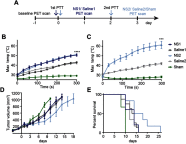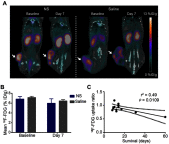Fractionated photothermal therapy in a murine tumor model: comparison with single dose
- PMID: 31409993
- PMCID: PMC6645692
- DOI: 10.2147/IJN.S205409
Fractionated photothermal therapy in a murine tumor model: comparison with single dose
Abstract
Purpose: Photothermal therapy (PTT) exploits the light-absorbing properties of nanomaterials such as silica-gold nanoshells (NS) to inflict tumor death through local hyperthermia. However, in in vivo studies of PTT, the heat distribution is often found to be heterogeneous throughout the tumor volume, which leaves parts of the tumor untreated and impairs the overall treatment outcome. As this challenges PTT as a one-dose therapy, this study here investigates if giving the treatment repeatedly, ie, fractionated PTT, increases the efficacy in mice bearing subcutaneous tumors. Methods: The NS heating properties were first optimized in vitro and in vivo. Two fractionated PTT protocols, consisting of two and four laser treatments, respectively, were developed and applied in a murine subcutaneous colorectal tumor model. The efficacy of the two fractionated protocols was evaluated both by longitudinal monitoring of tumor growth and, at an early time point, by positron emission tomography (PET) imaging of 18F-labeled glucose analog 18F-FDG. Results: Overall, there were no significant differences in tumor growth and survival between groups of mice receiving single-dose PTT and fractionated PTT in our study. Nonetheless, some animals did experience inhibited tumor growth or even complete tumor disappearance due to fractionated PTT, and these animals also showed a significant decrease in tumor uptake of 18F-FDG after therapy. Conclusion: This study only found an effect of giving PTT to tumors in fractions compared to a single-dose approach in a few animals. However, many factors can affect the outcome of PTT, and reliable tools for optimization of treatment protocol are needed. Despite the modest treatment effect, our results indicate that 18F-FDG PET/CT imaging can be useful to guide the number of treatment sessions necessary.
Keywords: cancer; fractionated therapy; hyperthermia; nanoparticle; photothermal therapy; positron emission tomography.
Conflict of interest statement
Ms Marina Simón, Dr Kamilla Norregaard, and Dr Jesper Tranekjær Jørgensen report grants from Novo Nordisk Foundation, European Research Council, Lundbeck Foundation, Innovation Fund Denmark, Danish Cancer Society, Arvid Nilsson Foundation, Svend Andersen Foundation, Neye Foundation, Research Foundation from Rigshospitalet, Research Council for Independent Research, Research Council of the Capital Region of Denmark, and Danish National Research Foundation, during the conduct of the study. Professor Lene Broeng Oddershede and Professor Andreas Kjaer report no conflicts of interest in this work.
Figures






References
Publication types
MeSH terms
Substances
LinkOut - more resources
Full Text Sources
Other Literature Sources
Research Materials
Miscellaneous

